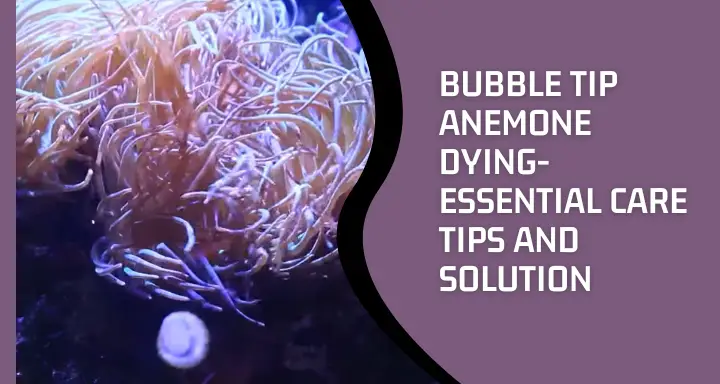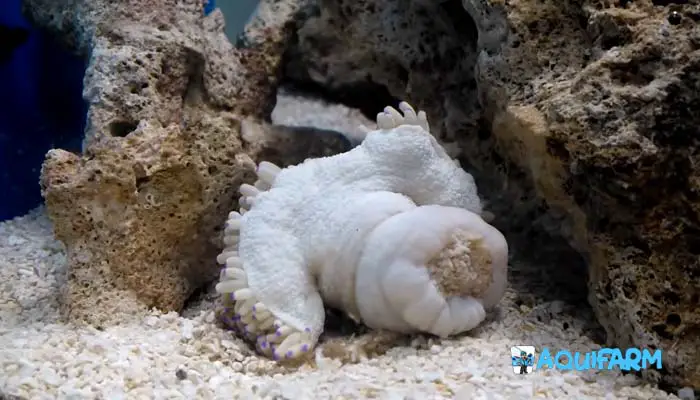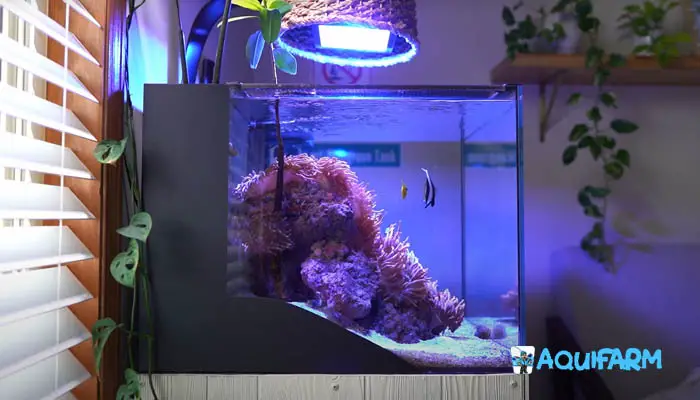
Are you facing the distressing issue of Bubble Tip Anemones dying in your aquarium? As a reef enthusiast, it can be disheartening to witness the sudden demise of these captivating sea creatures.
However, fear not! In this comprehensive article, I will delve into crucial considerations and care techniques that can make all the difference in keeping your Bubble Tip Anemones healthy and thriving.
From understanding their specific water requirements to providing appropriate lighting and strategic placement, we will explore every aspect that contributes to the well-being of your bubble tip anemones. Additionally, we’ll discuss feeding techniques, nutrient needs, and selection criteria to ensure optimal conditions for these delicate creatures.
If you’re seeking effective solutions to prevent Bubble Tip Anemone deaths and promote their longevity, you’ve come to the right place. Get ready to discover the facts that will help you revive and sustain your Bubble Tip Anemones.
Problems | Solutions |
| Unfavorable water temperature | Maintain a temperature between 25℃ to 28℃ in the tank. |
| Inaccurate water flow | Maintain moderate water flow and use pumps in the aquarium as per need. |
| Improper lights | Provide your anemones with a light requirement of 220-350 PAR or 5 watts for each gallon of water. |
| Wrong placement of anemones | Place anemones in a mature and properly acclaimed tank with a sufficient environment. |
| Wrong feeding techniques | Feed your anemones seafood, shrimps, and squids and provide food 1 to 3 times a week. |
| Imbalanced nutrition | Provide low doses of iodine, phosphate, and nitrate to maintain the alkalinity. |
| Improper selection | Pick aqua cultured healthy anemones over the wild variants. |
How to Save Dying Bubble Tip Anemone

How to tell if a Bubble tip anemone is dying?
Before starting the cures, Tou might have been wondering what a dying Bubble Tip anemone looks like. Well, with some common symptoms, you can have an idea of this.
Normally, anemones have a tendency of deflating after expelling the old water from their body. If they don’t get back to their original shape within 3 to 4 days, it can be a clear indication that they are on the verge of death. Also, a major reduction in the actual size of anemones can tell you the same.
Sometimes you may observe some loose tissues coming out with splitting in your Bubble Tip anemones. Besides that, they can start to detach from the base rocks. These are some common symptoms of illness and dying anemones.
Additionally, the inverted mouth and flat tentacles are also alarming. They can start losing their actual colors and appearance. In such a stage, the symbiosis associated with Zooxanthellae decays causing severe thriving for foods. Thus, your anemones may die.
Moreover, your tank water may turn cloudy or milky white with the decaying parts of dead anemones indicating that your Bubble Tip anemones are no longer alive. Your room may be filled with the bad odor of dead anemones in such a case.
Now, you might be thinking about how to save a dying Bubble Tip anemone. Well, I also got the rescues. Let’s check these out together.
1. Water Temperature

Before placing your Bubble Tip anemone in the tank, proper acclimation is important. Normally, they prefer a temperature of 25℃ to 28℃. So, you have to adjust the level to maintain your anemones.
A good quality testing kit is necessary to trace the water changes in your reef tank. This will tell you the conditions inside.
Now, let’s check how you can maintain the temperature to save dying anemone.
Management
First of all, you need to practice proper and scheduled water changing. You may replace your tank water once a day to keep a consistent water temperature.
To control heat generation from your aquarium lights, you may turn these off for a while. Also, place your reef tank in a shady place so that direct sunlight can’t pass through.
Another good practice is placing a net covering rather than a solid one. Then you may place some kind of air cooler or electric fans to allow aeration that can help in reducing the heat.
Now. Let me tell you about an easy trick to cool down the water. All you can do is put some ice in your tank. But, be careful that your aquarium’s living organisms don’t come in direct contact with the ice.
On the contrary, to increase the temperature, adjust the lighting in the tank. Good exposure to natural lights can give a boost. So, it is advised to place your tank close to any light source.
You may also put warm water in the tank. But make sure that you are providing the correct temperature to your anemones.
Last but not least, keep checking the water temperature often to understand what you need to do.
2. Water Flow
Bubble tip anemones need a proper water flow to survive. However, some growers argue that excessive flow may cause stretching but the lower flow will keep the tentacles intact. So, we will focus on maintaining a moderate flow in the aquarium.
Well, here I got some suggestions to ensure proper flow in the aquarium to save your bubble tip anemones. Keep reading to know more.
Management
To nurture your anemones with adequate water flow, you may need to remove the dead portions and other debris from your tank. Also, keep your anemones away from the corals. Sometimes they can cause corals to die and add depositions that can hinder the regular flow of water.
Installing a wavemaker will do half of your job. This can help in adjusting the whirls inside your tank so as to keep your bubble tip anemones intact.
Powerhead pumps are also helpful in diverting water flow to a particular place. So, to control excessive flow, you can locate your pumps in such a way that it takes some surrounding water from the place of your anemones and pushes it to other sides.
3. Light requirements
Proper lights are important for both; anemones and their associated photosynthetic microorganisms. To provide the necessary energy, elevated lights, mostly 220 to 350 PAR are needed.
However, messing up with lights can cause splitting in anemones and eventually kill them. That’s why it should be your serious concern. Here I got some important measures to fix the light issues in the aquarium. So, let’s dig a little deeper.
Management
As Bubble Tip anemones have a powerful fluorescence, proper light is quite obvious factor to maintain this attribute. To serve this purpose, you can place alchemical lights or fluorescent bulbs, or blue LEDs in your aquarium. Metal halides, VHO sets, or PC lights are also helpful in maintaining necessary conditions.
However, in the reef tank, a higher output of light between 220 to 350 PAR is needed. So, you can adjust your lights in between this range.
Also, Bubble Tip anemones require 5 watts of light per gallon of water. If it feels a bit hard to maintain, I would suggest you place some light-hungry anemones at the top region of the tank. This will provide powerful lights.
4. Placement of Anemones
Due to the nomadic behavior of Bubble Tip anemones, it’s hard to detect where they are actually going to be set for. You may find them clinging to any rocks or tank walls.
Management
First of all, you may need to place your anemones in tanks according to their size and number. Normally, an aquarium having a water capacity of 110 to 115 liters is enough most of the time.
As Bubble Tip anemones have the necessity of solid placement, you have to acclaim the water parameters properly with steadiness before putting them in tanks. Improper acclimation and lights can cause the death of anemones. Try to place your anemones on a rock away from any corals nearby. While putting them in the tank for the first time, turn off the pumps and let them settle.
Another important factor is the age of the tank. Yes, you heard it right. You need to place an anemone in a tank of at least 6 months old. As mature tanks have better acclimation, it helps Bubble Tips to adjust better. In a fresh tank, they may struggle with proper placement and die eventually.
Finally, keep observing your anemones right after placing them in the tank. Their behavior will say a lot about the overall requirements. Treat them as I have mentioned.
5. Foods for Anemones
Bubble Tip anemones are not that fussy when it comes to food preferences. So, you can introduce them to different types of foods. But you need to be careful about some factors.
Actions should be taken according to the responses of your anemones. Also, some criteria need to be considered while feeding Bubble Tip anemones. Thinking what these can be? Here I have mentioned all of them. So, let’s jump in.
Feeding Techniques
Bubble Tip anemones are closely associated with the photosynthesizing microorganisms, Zooxanthellae, that take energy from the lights as food. So, you may need to maintain the proper lighting in the tank.
Also, these organisms are highly in need of proteins. Small meaty nibbles of seafood, mostly brine shrimp will meet the need. So, you can place these in your tank to let the Zooxanthellae process efficiently.
While experimenting with several foods, you need to observe the behavior of your Bubble Tip anemones. This will help in understanding the feeding frequency. Generally, anemones are used 1 to 3 times feeding every 7 days. So, you can follow this pattern.
For feeding, in the case of small anemones, you can try some reef feeds available on the market. When they grow up, you may start with Mysis shrimp and squids. Then introduce them with larger bites, like frozen reef foods, silversides, or fresh shrimps.
Petting clownfish in the aquarium of anemones will do a great job. These will help in feeding. However, do not overfeed your Bubble Tip anemones as this may lead to pooping.
You may also notice that Bubble Tip anemones are closed up when they are being fed. It’s normal while having food or clownfish around them. So you don’t need to worry much about this.
Sometimes they may only attach the food with their tentacles but won’t eat it later. If such happens, it’s advised to remove these uneaten foods from the anemones within an hour.
It’s also important to remove crumbled foods from the tank. Otherwise, these can create a toxic environment for your anemones and other tank habitats.
Always place the foods with the help of metallic sticks or tongs. Do not dip your hands directly into the tank while placing. Place foods with the minimum disturbance onto the tentacles of your anemones. Be careful not to push foods directly into the mouth.
6. Nutrient Check
Bubble Tips thrive for some balanced nutrients. Imbalanced nutrition and unwanted formulas are always disturbing to them. Sometimes you might notice Bubble Tip anemones are melting, which is a clear sign that they are screaming for some help.
Let’s check how you can handle such conditions. Keep reading to discover more.
Control Measure
Bubble Tip anemones prefer low doses of iodine, phosphate, and nitrate. These are mainly for balancing the alkalinity in the tank. You can add seashells or crushed limestones to maintain the nutrient level. For a tank of 30 gallons of water, 2 seashells would be enough. And in the case of limestones, you can add one teaspoon to 5 gallons of water.
However, there must not be any trace of ammonia and nitrite in your tank water. If your indicators are showing the presence of any of these, I would recommend you change the water and replace it with a fresh one as soon as possible.
7. Selection of Anemones
Selection is an important factor in growing the Bubble Tip anemones. There are different sources and criteria to look for when choosing anemones to grow in a reef tank.
So let’s see what these can be.
How to Pick the Right Anemones to Grow?
It has been observed that aquacultured anemones are much more resistant in different attributes than wild ones. These are cheaper comparatively. So, you might go for these.
You may pick anemones of a diameter between 7 to 10 centimeters. This is the ideal measure to pick which will lead them to healthy growth in your tank. It’s even observed that smaller anemones have better survivability than larger ones. That’s why these smaller ones won’t disappoint you.
Besides, while purchasing, look for a good attachment of anemones with the base substrates. You may also check the feet. These should be healthy without any cuts. An anemone with a damaged foot often succumbs to death in the long run.
FAQs
Why Is My Bubble Tip Anemone Turning Brown?
Bubble Tip anemones turn brown or get discolored when the associated zooxanthellae start leaving them due to some sort of stress condition. You may also notice the loss of tips in anemones when such happens.
How To Know If A Bubble Tip Anemone Is Healthy Or Not?
The mouth and the tentacles can initially tell about the health of your Bubble Tip anemones. Normally closed and wrinkled appearances are considered to be normal in anemones. Healthy feet with proper anchorage also help to ensure that they are doing well.
Can A Dead Bubble Tip Anemone Kill Your Fish?
Bubble Tip anemones are carnivores in nature, so unfortunately the living anemones can sting and kill your fish. When dead, their residues can pollute tank water which may also cause death to your fish.
Can Multiple Bubble Tip Anemones Stay Together?
The answer is yes, they can stay. Normally 10 to 20 Bubble Tips can live with one another. But you have to be careful in such a case and choose close relatives. Distance variants can be destructive to each other.
Can A Bubble Tip Anemone Regenerate?
Bubble tips can regenerate through asexual reproduction, mostly by splitting and duplicating. However, they can also produce babies by sexual reproduction.
Read More-
Conclusion
I kept my promise. Here I have mentioned almost all the possible factors that can be manipulated to save your dying Bubble Tip anemones.
All you need to do is acclaim proper water and light conditions in your reef tank and then select the right anemones to put. Also, be careful about the right placement and providing them with proper food. Finally, maintain them by integrating all the management to keep Bubble Tip anemones healthy and alive.
You can come back to my articles whenever needed. The comment section is open for you as I am always here to help. May your reefing journey be bright and enjoyable with vivid anemones.
- Top 15 Freshwater Aquarium Plant Ideas for a Lush, Green Tank - November 9, 2024
- Top 13 Freshwater Aquarium Layout Ideas for a Beautifully Organized Tank - November 9, 2024
- 14 Stunning Rustic Freshwater Aquarium Ideas for a Tranquil Environment - November 9, 2024
